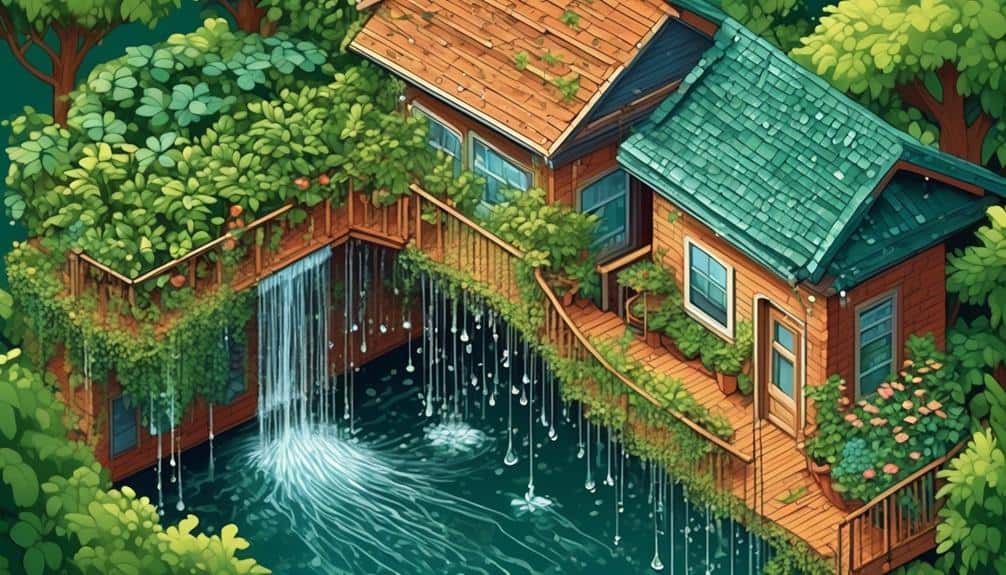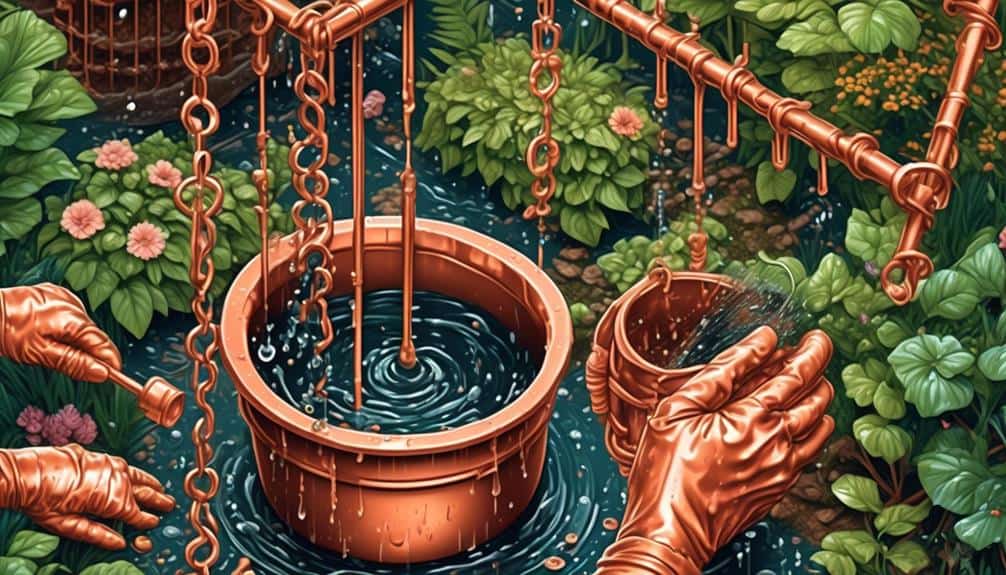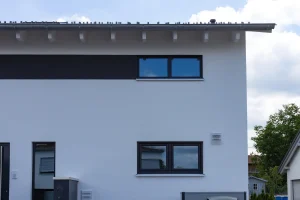Are rain chains the perfect blend of function and style for your home’s water management? These decorative alternatives to traditional downspouts guide water from your gutters while creating stunning visual displays during rainfall.
At Guttering Services, we install rain chains that enhance property aesthetics across Limerick and Clare. These Japanese-inspired water features not only prevent foundation damage and soil erosion but also create peaceful water sounds and eye-catching focal points for your home’s exterior.
While the capacity of rain chains might vary based on design, with appropriate planning and positioning, they serve as a functional and decorative element in home maintenance.
This guide explains rain chain styles, installation requirements, and how they compare to traditional downspouts. We’ll help you choose the right design for your home’s architecture and show how our professional installation ensures both beauty and functionality.
Contact Guttering Services today for a free consultation on transforming your downspouts with elegant, effective rain chains that protect and beautify your property.
Key Takeaways
- A rain chain is used to direct water flow from gutters to the ground, slowing down aggressive rainfall.
- Rain chains are less sturdy and have less water capacity than traditional downspouts.
- They can be used without gutters, but choosing the right style for your climate and water volume is crucial.
- The bottom of a rain chain often features a water collection system, such as a pot filled with stones or water-loving plants.
What Are the Downsides of a Rain Chain?

Despite the aesthetic and functional advantages of rain chains, they do present certain drawbacks that homeowners need to consider.
While they add a decorative aspect to your home’s exterior and provide a calming water feature, their functionality can be limited in certain conditions.
-
Limited Durability: Unlike sturdy downspouts, rain chains may not withstand high wind conditions or heavy rainfall. This makes them less suitable for areas prone to such weather patterns.
-
Reduced Water Capacity: Rain chains do not have the same water capacity or control as traditional downspouts. This can lead to water overflow during heavy rain, possibly causing damage to your property.
-
Potential Gutter Damage: Rain chains can be heavy, particularly when laden with water. Weaker gutter materials may not be able to bear this weight and could become damaged.
-
Freezing Issues: In colder climates, rain chains can freeze over in the winter. While this can create a beautiful icy display, it also requires monitoring to ensure excessive ice does not compromise the chain’s functionality or safety.
Therefore, while rain chains offer numerous benefits, these potential downsides should be weighed before installation.
How Do Rain Chains Work if You Don’t Have Gutters?
While gutters are typically associated with rain chains, it is indeed possible to utilise these decorative features even if your house lacks a gutter system.
The key is to install a system that allows rainwater to effectively reach the chain. A short gutter section with a hole at the end where the chain hangs, or a 90-degree corner leader head, which fits into the intersection of two roofs, can serve this purpose.
Without gutters, the choice of rain chain style becomes even more important. Cup-style rain chains, which can handle a greater volume of water than link-style chains, are often more suitable for gutter-less scenarios.
Below is a table that illustrates some considerations when using rain chains without gutters.
| Consideration | Description |
|---|---|
| Installation | A short rain chain gutter section or a leader’s head needed |
| Chain Style | Cup-style chains are recommended for greater water capacity |
| Water Collection | Consider what will catch the water at the bottom |
| Maintenance | Regular checks to ensure effective water flow |
Ultimately, even without gutters, rain chains can be a practical and aesthetically pleasing way to manage rainfall around your home.
Can You Keep a Rain Chain Outside During Winter?

Maintaining a rain chain during winter months is indeed feasible, though it does require some considerations.
While rain chains are designed to withstand the elements, the winter season presents unique challenges.
-
Ice Formation: In colder climates, rainwater can freeze on the chain, adding extra weight. This can potentially damage the chain or its attachment to the gutter if not carefully monitored.
-
Chain Length: A longer chain may collect more ice, increasing the risk of damage. Consider shortening the chain during winter months to reduce this risk.
-
Material Considerations: Rain chains made from materials like copper are more resistant to winter damage, while those made from less durable materials may suffer.
-
Location: Rain chains may freeze and create icicles, which could pose a hazard if located near walkways. Ensure your chain is well away from areas of foot traffic.
Can Rain Chains Take the Place of Gutters?
Rain chains, with their aesthetic appeal and functionality, are often considered an alternative to traditional gutters; however, several factors come into play when evaluating their effectiveness in different settings.
While rain chains serve to direct the rainwater from your roof to the ground, they do have certain drawbacks such as lower sturdiness, less water capacity, and potential damage to weaker gutter materials.
| Pros of Rain Chains | Cons of Rain Chains |
|---|---|
| Aesthetic Appeal | Less Sturdy |
| Slows Down Rainwater | Lower Water Control |
| Versatile Designs | Possible Damage to Gutters |
However, if your geographical location experiences mild rainfall and lesser winds, rain chains could be a viable option, offering the dual benefit of functionality and visual appeal.
Further, it is possible to install rain chains without a gutter, using structures like a short gutter section or a leader’s head.
In such cases, cup-style rain chains could be more beneficial due to their increased water-handling capacity.
What Should You Put at the Bottom of a Rain Chain?

To effectively utilise a rain chain, it is crucial to consider what should be placed at the bottom to catch the rainwater.
The receptacle you choose must not only serve a functional purpose but also enhance the aesthetic beauty of the rain chain.
Here are four potential options:
- Basin or Bowl: A large, wide-mouthed basin or bowl can effectively catch the rainwater trickling down the chain. This could be made of ceramic, metal, or even plastic, depending on your preference.
- Rain Barrel: For those interested in water conservation, a rain barrel can be used. This allows the collected rainwater to be repurposed for watering plants or washing cars.
- Garden Bed: Direct the rain chain such that it waters a flower or vegetable bed. This is a sustainable option that keeps your greenery hydrated.
- Pebble or Stone Bed: A bed of pebbles or stones can serve as a beautiful and natural way to catch and disperse the water, minimising the risk of soil erosion near your home’s foundation.
Should a Rain Chain Reach the Ground?
While considering the placement of a receptacle at the base of the rain chain, one must also address whether the rain chain itself should reach the ground.
Ideally, the rain chain should reach the ground to direct water away from your home’s infrastructure, preventing any potential damage.
However, it should not lay flat on the ground but rather be elevated slightly to allow the water to disperse properly.
Different factors may affect this, such as the style of your rain chain, the height of your gutter, and the kind of receptacle you plan to use.
For instance, cup-style rain chains are more efficient in handling water and may require less length compared to link-style chains.
The following table provides guidance on rain chain length based on these factors:
| Rain Chain Style | Gutter Height | Receptacle Type | Suggested Chain Length |
|---|---|---|---|
| Cup-Style | High | Deep Basin | Ground Level |
| Link-Style | Low | Shallow Basin | Slightly Above Ground |
| Mixed Style | Medium | Medium Basin | Ground Level |
Can Rain Chains Be Used in Conjunction with Rain Barrels?
Yes, rain chains can be used in conjunction with rain barrels. Rain chains are a decorative alternative to traditional downspouts, allowing rainwater to flow from the gutters into the rain barrels. This is a visually appealing and efficient way to collect and store rainwater, supporting how rain barrels work.
Frequently Asked Questions
What Does a Rain Chain Do?
A rain chain is a decorative yet functional tool that guides rainwater from the roof and gutters to the ground. They effectively reduce clogging and add aesthetic appeal to the exterior of a property.
What Is the Downside to a Rain Chain?
The primary downsides of rain chains are their limited capacity for handling heavy rains and their ineffectiveness in windy conditions. Additionally, they require a collection system and backup downspouts are often needed in areas with frequent rainstorms.
What Do You Put at the Bottom of a Rain Chain?
At the bottom of a rain chain, one can place pebbles or stones for drainage and erosion prevention. Additionally, a decorative basin, a small garden, or a rain barrel could be utilised for aesthetic or conservation purposes.
Does a Rain Chain Have to Attach to a Gutter?
No, a rain chain does not necessarily have to be attached to a gutter. It can be installed in any area where water accumulates, using gutter clips for support or stakes and anchors for additional stability.






